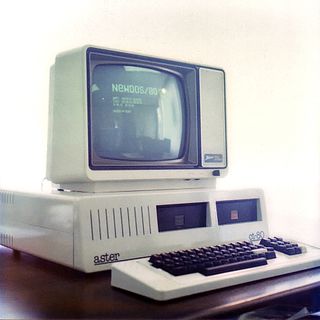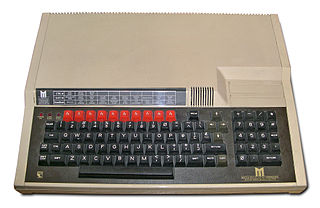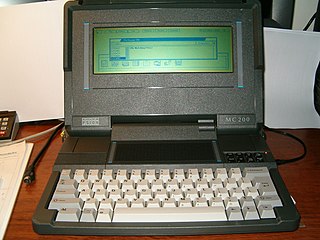
The Aster CT-80 is a 1982 personal computer developed by the small Dutch company MCP, was sold in its first incarnation as a kit for hobbyists. Later it was sold ready to use. It consisted of several Eurocard PCB's with DIN 41612 connectors, and a backplane all based on a 19-inch rack configuration. It was the first commercially available Dutch personal/home computer. The Aster computer could use the software written for the popular Tandy TRS-80 computer while fixing many of the problems of that computer, but it could also run CP/M software, with a large amount of free memory Transient Program Area, (TPA) and a full 80×25 display, and it could be used as a Videotext terminal. Although the Aster was a clone of the TRS-80 Model I it was in fact more compatible with the TRS-80 Model III and ran all the software of these systems including games. It also had a built-in speaker which was compatible with such games software.

The Amstrad CPC is a series of 8-bit home computers produced by Amstrad between 1984 and 1990. It was designed to compete in the mid-1980s home computer market dominated by the Commodore 64 and the ZX Spectrum, where it successfully established itself primarily in the United Kingdom, France, Spain, and the German-speaking parts of Europe.

Amstrad was a British consumer electronics company, founded in 1968 by Alan Sugar. During the 1980s, the company was known for its home computers beginning with the Amstrad CPC and later also the ZX Spectrum range after the Sinclair deal, which led it to have a substantial share of the PC market in Britain. In the following decade it shifted focus towards communication technologies, and its main business during the 2000s was the manufacture of satellite television set-top boxes for Sky, which Amstrad had started in 1989 as the then sole supplier of the emerging Sky TV service.

CP/M, originally standing for Control Program/Monitor and later Control Program for Microcomputers, is a mass-market operating system created in 1974 for Intel 8080/85-based microcomputers by Gary Kildall of Digital Research, Inc. CP/M is a disk operating system and its purpose is to organize files on a magnetic storage medium, and to load and run programs stored on a disk. Initially confined to single-tasking on 8-bit processors and no more than 64 kilobytes of memory, later versions of CP/M added multi-user variations and were migrated to 16-bit processors.

The Amstrad PCW series is a range of personal computers produced by British company Amstrad from 1985 to 1998, and also sold under licence in Europe as the "Joyce" by the German electronics company Schneider in the early years of the series' life. The PCW, short for Personal Computer Word-processor, was targeted at the word processing and home office markets. When it was launched the cost of a PCW system was under 25% of the cost of almost all IBM-compatible PC systems in the UK, and as a result the machine was very popular both in the UK and in Europe, persuading many technophobes to venture into using computers. The series is reported to have sold 8 million units. However the last two models, introduced in the mid-1990s, were commercial failures, being squeezed out of the market by the falling prices, greater capabilities and wider range of software for IBM-compatible PCs.
Kaypro Corporation was an American home and personal computer manufacturer based in Solana Beach in the 1980s. The company was founded by Non-Linear Systems (NLS) to compete with the popular Osborne 1 portable microcomputer. Kaypro produced a line of rugged, "luggable" CP/M-based computers sold with an extensive software bundle which supplanted its competitors and quickly became one of the top-selling personal computer lines of the early 1980s.

The Osborne 1 is the first commercially successful portable computer, released on April 3, 1981 by Osborne Computer Corporation. It weighs 24.5 lb (11.1 kg), cost US$1,795, and runs the CP/M 2.2 operating system. It is powered from a wall socket, as it has no on-board battery, but it is still classed as a portable device since it can be hand-carried when the keyboard is closed.

The Apple IIc is a personal computer that was introduced by Apple Inc. shortly after the launch of the original Macintosh. It was a compact and portable version of the Apple II series of computers. The IIc featured a built-in floppy disk drive and a keyboard, and was often sold with its matching monitor. The c in the name stood for compact, referring to the fact it was a complete Apple II computer setup with a floppy drive that was squeezed into a smaller notebook-sized housing. It was compatible with a wide range of software and peripherals.

The Amstrad PC1512 was Amstrad's mostly IBM PC-compatible computer system, first manufactured in 1986. Next year a slight updated version named PC1640 was introduced. It was also marketed as PC6400, and Sinclair PC500. Schneider branded machines for the German market also exists.

MicroBee was a series of networkable home computers by Applied Technology, which became publicly listed company MicroBee Systems Limited soon after its release. The original Microbee computer was designed in Australia by a team including Owen Hill and Matthew Starr.

The TRS-80 Model 100 is a notebook-sized portable computer introduced in April 1983. It was the first commercially successful notebook computer, as well as one of the first notebook computers ever released. It features a keyboard and liquid-crystal display, in a battery-powered package roughly the size and shape of a notepad or large book. The 224-page, spiral-bound User Manual is nearly the same size as the computer itself.

The BBC Master is a home computer released by Acorn Computers in early 1986. It was designed and built for the British Broadcasting Corporation (BBC) and was the successor to the BBC Micro Model B. The Master 128 remained in production until 1993.

The Epson QX-10 is a microcomputer running CP/M or TPM-III which was introduced in 1983. It was based on a Zilog Z80 microprocessor, running at 4 MHz, provided up to 256 KB of RAM organized in four switchable banks, and included a separate graphics processor chip (µPD7220) manufactured by NEC to provide advanced graphics capabilities. In the USA and Canada, two versions were launched; a basic CP/M configuration with 64 KB RAM and the HASCI configuration with 256 KB RAM and the special HASCI keyboard to be used with the bundled application suite, called Valdocs. TPM-III was used for Valdocs and some copy protected programs like Logo Professor. The European and Japanese versions were CP/M configurations with 256 KB RAM and a graphical BASIC interpreter.
The Actrix computer, released in 1983 by Actrix Computer Corporation, was a Zilog Z80-based transportable personal computer running CP/M-80 V2.2. It was initially released as the Access Computer, made by Access Matrix Computer Corporation, but both the company and its product changed names after trademark disputes.

The Apricot Portable was a personal computer manufactured by ACT Ltd., and was released to the public in November 1984. It was ACT's first attempt at manufacturing a portable computer, which were gaining popularity at the time. Compared to other portable computers of its time like the Compaq Portable and the Commodore SX-64, the Apricot Portable was the first system to have an 80-column and 25-line LCD screen and the first with a speech recognition system.
Torch Computers Ltd was a computer hardware company with origins in a 1982 joint venture between Acorn Computers and Climar Group that led to the development of the Communicator or C-series computer, a system based on the BBC Micro with a Z80 second processor and integral modem, intended as a viewdata terminal.

The history of laptops describes the efforts, begun in the 1970s, to build small, portable Personal Computers that combine the components, inputs, outputs and capabilities of a Desktop Computer in a small chassis.

The TRS-80 Model II is a computer system launched by Tandy in October 1979, and targeted at the small-business market. It is not an upgrade of the original TRS-80 Model I, but a new system.
Protext is a British word processing program, developed by Arnor Ltd, of Peterborough in the decade following 1985. Originally written for the Amstrad CPC 464, it was later sold for the Amstrad PCW series of word processors, for MS-DOS based PCs, the Atari ST, and the Commodore Amiga.

The Psion MC series is a line of laptop computers made by Psion PLC and launched in 1989.

















